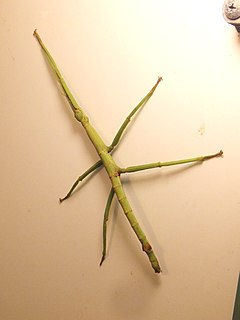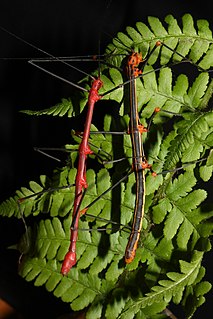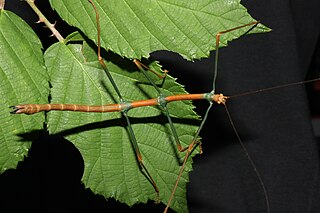
Phobaeticus is a genus of Asian stick insects comprising over 25 species.

Pharnaciini is a tribe of notably large stick insects.

Necrosciinae is a subfamily of the stick insect family Lonchodidae, with its greatest diversity in South-East Asia.

Pharnacia is a tropical Asian genus of stick insects in the family Phasmatidae and subfamily Clitumninae.

Diapheromerinae is a subfamily of the stick insect family Diapheromeridae. They belong to the superfamily Anareolatae of suborder Verophasmatodea.

Lonchodes is a genus of stick insects in the family Phasmatidae and the type genus of the family Lonchodidae and tribe Lonchodini. Species have a known distribution that includes tropical Asia and the Pacific.

Ramulus is an Asian genus of stick insects in the family Phasmatidae and subfamily Clitumninae.

Phryganistria is a genus of stick insects belonging to the subfamily Clitumninae. It was described by the Swedish entomologist Carl Stål in 1875. Members of the genus are found only in Southeast Asia. Of the new species described in 2014, Phryganistria heusii yentuensis, which is 32 cm long, is one of the longest insects known to date. Another, Phryganistria tamdaoensis was selected in 2015 by the International Institute for Species Exploration as one of the "Top 10 New Species" for new species discovered in 2014.

The Heteropterygidae is a family of stick insects belonging to the suborder Euphasmatodea. Species can be found in Australasia, East and Southeast Asia. More than 130 valid species have been described.

Pseudosermyle is a genus of walkingsticks in the family Diapheromeridae. There are more than 20 described species in Pseudosermyle.

The Lonchodinae are a subfamily of stick insects in the family Lonchodidae found in: Australasia, Asia, Africa, Southern America and the Pacific.

Medauroidea is an Asian genus of stick insects in the family Phasmatidae and subfamily Clitumninae. Species have been recorded from Indo-China.
Tirachoidea is an Asian genus of stick insects in the family Phasmatidae and tribe Pharnaciini. Species have a known distribution from India, Indochina and West Malesia.
Medauromorpha is an Asian genus of stick insects in the family Phasmatidae, subfamily Clitumninae and tribe Medaurini. Species have a known distribution from Vietnam and southern China.

The Gratidiini are a tribe of stick insects based on the type genus Clonaria and first used by Cliquennois in 2005. Genera are known to be distributed in: Africa, Europe, temperate and tropical Asia and various Pacific Islands.

The Platycraninae are an anareolate subfamily of stick insects in the family Phasmatidae. Their known distribution includes southern, southeast Asia and Australasia.

The Obriminae are the most species-rich subfamily of the Phasmatodea family Heteropterygidae native to Southeast Asia. It is divided into two tribe.
Baculonistria is a genus of phasmids belonging to the family Phasmatidae, with records from China.

The Obrimini are the most species-rich tribe of the Phasmatodea family of the Heteropterygidae native to Southeast Asia.

The Cladomorphinae are a subfamily of stick insects in the family Phasmatidae. This taxon is particularly well represented in the Neotropical region, but records also exist for Madagascar, Java and the Maluku Islands.


















